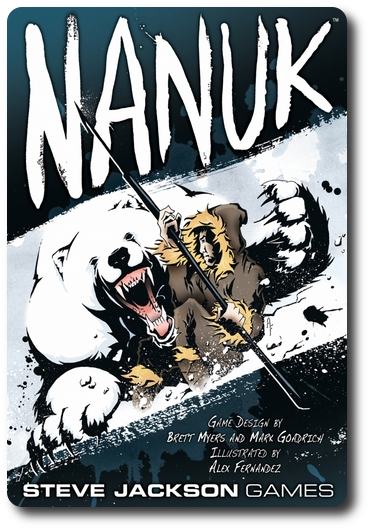
The Basics:
- For ages 13 and up
- For 5 to 8 players
- Approximately 30 minutes to complete
Geek Skills:
- Active Listening & Communication
- Counting & Math
- Logical & Critical Decision Making
- Pattern/Color Matching
- Strategy & Tactics
- Risk vs. Reward
- Cooperative & Team Play
- Hand/Resource Management
- Bluffing and Misdirection
- Bidding
Learning Curve:
- Child – Moderate
- Adult – Easy
Theme & Narrative:
- Boast of your bravery and skill and then go hunt on the ice hoping your butt can cash the check your mouth wrote
Endorsements:
- Gamer Geek approved!
- Parent Geek rejected!
- Child Geek rejected!
Overview
In the tribal culture of the Inuits, stories are told of brave hunters who risk it all. These stories entertain as well as teach the listener that endurance of the mind and spirit are essential to survival for the individual as well as the tribe. But bravery must be tempered with wisdom and boasting and bragging can be just as dangerous as a confrontation with a hungry polar bear. The truly wise and truly brave know that nothing can be accomplished without teamwork, but at the same time, failure is sure to follow a pack of fools. In which group do you want to be placed and how much are you willing to risk to obtain legendary status?
Nanuk, by Steve Jackson Games, is comprised of 100 cards, 1 game board, 1 Day token, 3 Wind tokens, 10 Number tokens, and 10 Hunt/Doom tokens. Note that there are more tokens than are necessary to play and are provided as extras for easy replacement of lost or damaged pieces.
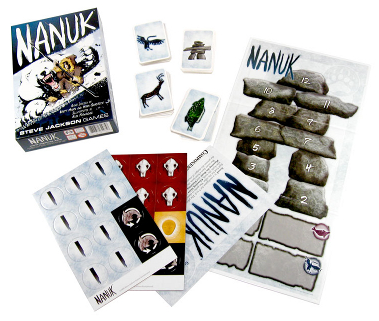
The Tools of a Hunter
The different game bits deserve a brief explanation. Failure to use them correctly (or even know what they are good for) is going to lead the hunting party to certain doom.
The Game Board
The game board is used to represent player order, the number of extra card draws a hunt can have in hopes of making its boast, and the number of animals that are necessary to collect in order for the hunt to be successful. The game board keeps tack of all this and the Day and Number tokens are constantly being moved during each round. The game board is essential to the game play as it keeps track of what is necessary to win and what is necessary to avoid to ensure your opponents don’t get points!
The Cards
The cards represent the four different animals the hunters will be attempting to find on the barren ice. These are the caribou, the seal, the fish, and the bird, respectively. The cards will either show one or two images of the animal. For easy reference, the animal image on the cards matches the animal images on the game board. Some of the cards also have a small icon of a polar bear. This is Nanuk, the master of all polar bears, and could mean certain doom for the hunting party . This mythic polar bear’s aggression can only be avoided with another special card, the Inuksuk (a stone landmark or cairn), which looks a good deal like the number track on the game board.
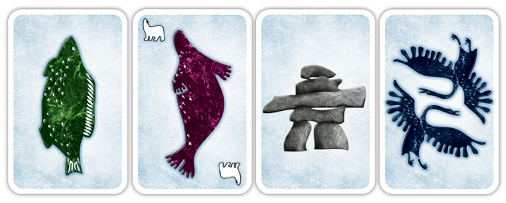
The Wind Token
The Wind token looks like a killer whale who is either swimming clockwise or counter-clockwise. This token is placed on the game board in the upper right-hand corner and determines the direction in which the game is played starting from the dealer. The direction of game play can change every round.
The Day and Numbers Token
The Day and Number tokens are used during boasting (the bid). The Number tokens keep track of how many animals are needed for a successful hunt and the Day token keeps track of how many additional cards are drawn to be part of the overall cards contributed to the hunt if it is not successful before the first day is over.
The Hunt/Doom Token
This is a double-sided token that each player will have. On one side is an image of crossed spears. This is the “Hunt” side and it means the player is going on the hunt, believing that what was boasted can be obtained using the cards supplied by the players. The other side is an image of a skull. This is the “Doom” side and means the player is not going on the hunt, believing the hunt will fail based on what was boasted.
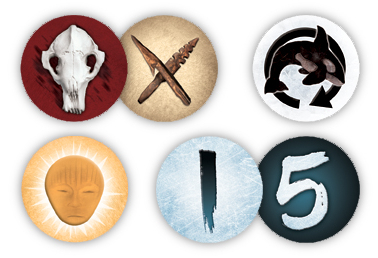
Preparations Before the Hunt
To set up the game, first place the game board in the middle of the playing area and give each player 1 Hunt/Doom token.
Second, shuffle the cards and deal out to each player, face-down, 3 cards. The players are welcome to look at their cards but should keep them hidden from their opponents at all times. The rest of the deck is placed to one side of the board, face-down.
Third, place the Wind, Day, and Number tokens to the side of the game board and within easy reach of all players.
You are now ready to play. The dealer of the cards goes first.
Of Boasts and Bravery
At the beginning of each round, the dealer takes and flips the Wind token (like a coin). The Wind Token is then placed on the game board on the side that is shown when it is flipped and shows in what direction the game play will take, either clockwise or counter-clockwise around the table.
The dealer is the first to begin and places the Day token on any numbered space on the Inuksuk and a Number token on any of the four animals. The minimum bid is 1 animal in 1 day. They then boast loudly of their skill as a hunter and state they could easy hunt “X” amount of a specific animals in so many days or less, depending on what they selected. It is now the next player’s turn, as determined by the Wind token.
The next player, and all following players, must now do one of the following:
- Increase the number of days of the hunt using the Day token
- Increase the number of animals using the Number tokens (changing the animal to be hunted is permissible)
- Increase both the number of days and animals (again, changing the animal to be hunted is permissible)
- Declare the hunt is doomed
The player needs to think about a few things before they take any action. First off, what is being changed on the game board is the bid for the round. What the players are attempting to do to win the game is collect sets of cards. This is only done if the player is on a successful hunt or if they properly guessed if the hunt was doomed. Each player needs to take into account how many animals they have in their hand, how many animals they think the other player’s have, and the likelihood of the current bids success before they even touch the game board.
If at anytime the player thinks the boast has gone too far, they should declare in a very loud voice, “THIS HUNT IS DOOMED! DOOOOOOOOOOOOOOMED!”
DO-DO-DOOOOOOOOMED!
As soon as a player declares the hunt is doomed, the bidding stops. The last player who boasted (updated the bid) is automatically the Hunt Leader. They place their Hunt/Doom token out in front of them, showing the hunt side. The player who declared the hunt was doomed is automatically the Doom Leader. They place their Hunt/Doom token out in front of them, showing the doom side. All the other players must now make a choice, but not before the Hunt and Doom leader have a chance to persuade the rest of the players why they should side with them. The Hunt and Doom leaders should now wax poetically about how right they are (and how wrong the other player is) in an attempt to have as many players as possible side with them. Once each leader has had a chance to persuade the table, the other players have an important decision to make.
Taking their Hunt/Doom token, all the other players (except the two leaders) must now decide if they want to support the hunt or believe it is doomed to fail. If they believe the hunt can succeed, they will select the hunt side of their token and will be able to provide as many cards as they like to the total pile that will represent what animals were found on the ice. If they believe the hunt cannot succeed, they will select the doom side of their token and must contribute one card to the total pile, but this card will not impact the hunt whatsoever.
On the count of three, all players now reveal their choice. Now it gets interesting.
Hunting On the Ice
Those who decided to go on the hunt now place as many cards as they like into a single pile of cards, face-down. Remember, the goal is to collect a total number of animals as indicated by the boast (bid). Players who want the hunt to succeed should put cards with those animals into the pile, but they should also put other cards into the pile that they want to collect and score at the end of the game. Hunters should also add the Inuksuk to the pile if they believe there is any danger of the hunt failing. The last hunter to contribute cards is the Hunt Leader.
Those who decided the hunt was doomed must place one card from their hand under their Hunt/Doom token, face-down. These cards are not counted when determining the hunts success. Doomsayers should place cards they want to collect and score if the hunt fails.
The Hunt Leader takes all the cards in the pile created by the hunters, shuffles them, and reveals them one at a time, placing them into two separate piles. These piles are animals that help the hunt and animals that have nothing to do with the hunt. Any Inuksuk cards found in the pile are placed to the side and are not used yet. All Nanuk icons are ignored during this phase of the hunt.
Now the Hunt Leader draws one card from the card deck for each day indicated in the boast. For example, a two-day hunt (based on the boast) will mean the hunting party will draw 2 cards. One card is drawn at a time. Based on the card drawn, the following occurs:
- If the card shows an animal, it is placed in one of the two piles (those needed for the hunt and those that are not)
- If the card shows an Inuksuk, it is placed to one side
- If the card shows the icon of Nanuk, the hunt immediately fails unless Nanuk can be matched with an Inuksuk card – if there is a match, continue or if not, stop drawing cards
This continues until one card has been drawn for each day boasted or Nanuk comes out and cannot be blocked. The Hunt Leader should again count the number of animals to determine if the hunt succeeds. Of course, if Nanuk is not blocked, the hunt fails automatically.
Rewards
After the hunt has ended, one of the two groups will be awarded based on their bravery or skepticism.
If the hunters succeeded, all the cards drawn, including those cards under the Doom tokens, are put into a single pile. All the hunters (none of the doomsayers) now take the same number of cards, using whatever method is agreed upon. The number of cards given to each hunter must be equal. Any cards not claimed are placed on the bottom of the card deck, but face up, so you’ll see the card’s face when drawing from the deck. Any collected cards are kept by the player to one side until the end of the game when they will be scored.
If the doomsayers succeeded, all the cards drawn, including those cards under the Doom tokens, are put into a single pile. All the doomsayers (none of the hunters) now take the same number of cards, using whatever method is agreed upon. The number of cards given to each doomsayer must be equal. Any cards not claimed are placed on the bottom of the card deck, but face up, so you’ll see the card’s face when drawing from the deck. Any collected cards are kept by the player to one side until the end of the game when they will be scored.
This completes the round. Each player is now dealt enough cards to make their hand size a total of 3 cards. If a face-up card is shown while dealing cards, immediately go to the endgame. If not, the next dealer is the last player in the previous round who was the successful Hunt Leader or the successful Doom Leader. This individual flips the Wind token and a new round begins.
Endgame and Scoring
At anytime during the game a face-up card is revealed in the deck, the game ends immediately. This will only happen when dealing new cards at the belonging of a new round or when continuing a hunt. If this happens when the hunt is happening, the hunt fails and the cards added to the hunt pile are discarded, as well as any cards under the Hunt/Doom tokens.
All the players now take their collected cards and attempt to make sets and pairs using the animal cards. Each animal card used in sets and pairs can only be used once. The one exception is any card that shows double animals. These cards can be used twice to complete a pair or a set. It is suggested the players place their cards out in front of them to help with the scoring.
- For every pair of animals, 1 point is earned
- For every set of animals (1 caribou, 1 seal, 1 fish, and 1 bird), 3 points are earned
- The player with the most Nanuk cards (those cards that show the Nanuk icon) earns a bonus of 2 points
- The Inuksuk card is considered a wild card and can be used to complete any pair or set, but only once
All the points are counted and added. The player with the most points wins the game!
Game Variants
There are two included game variations in the rules that can be used to slightly alter the game play. They are summarized here.
- Longer Game: The game is played in “seasons” where each completed game is considered one hunting season. After so many seasons, the total number of points is scored with the winner being the player with the most points.
- Visible Turn Order Support: Instead of having all the players simultaneous reveal their support for the hunt, beginning with the next player in the direction of the Wind token from the Doom Leader, they reveal their support for the hunt, and then the next player does the same, and so on until everyone has revealed their Hunt/Doom token in turn order sequence.
To learn more about Nanuk and read the full rules, see the game’s official web page.
Prediction
At first blush, this game would appear to be a slightly more socially complicated version of Liar’s Dice with a bit of Werewolf and Battlestar Galactica mixed into it. To be perfectly honest, I have no idea how well this game is going to be perceived by our test groups. If I had to guess, I’d say it would be approved by the all three groups, but I have a nagging feeling it will not. There are some subtle complexities with the scoring and boasting that might be a bit too complicated for the Child Geeks and non-gamers. And yet, it does have the party-like feel to it with the support of 8 players, complete with table banter.
Yep, I have no idea how this is going to go, so let’s just get to it.
Teaching the game to my 8-year-old didn’t take long. There isn’t much to this game in regards to actual game rules. I attempted to teach the game to my 5-year-old, but he quickly lost interest, despite how cool it sounded to hunt polar bears. I spent most of my time focusing on the card scoring and the importance of determining the level of risk based on the boast. My little geek said he understood, but I think he understood it more from the academic sense versus the game application sense. And so, I gathered some additional friends and we played the game. But before I did, I asked my little geek his thoughts on the game so far.
“This looks to be an easy game, but I think it is going to be hard because I can’t trust anyone who I am playing with.” ~ Liam (age 8)
An oustanding observation and he is absolutely correct. This is a game where you must put your trust in other players based on nothing but the possible chance they can help the group succeed. People who say they support the hunt might have terribly underestimated their ability to contribute or be a doomsayer in disguise. This leaves the player with little to pin their hopes on in some cases. Let’s get going on the game and see if Nanuk is worth the hunt or we come back empty-handed.
Final Word
For the Child Geeks, this game served to be frustrating and confusing. There was just too much going on at the table. Much of the time, according to my little geek, he felt like he was just guessing. Even after I took him aside and reviewed how he was playing, he never felt good about the game play experience. This was a surprise to me because he has played Liar’s Dice and Werewolf before and had a great time. In the end, however, this game wasn’t for him and he couldn’t give it his approval. The other Child Geeks we tested the game with had more or less the same reaction.
Parent Geeks were a very mixed group. For those Parent Geeks who were also Gamer Geeks, they enjoyed themselves a great deal. For those who were not, especially the non-gamers, they never seemed to “get it”. The endgame scoring wasn’t an issue, but how to get the cards kept them befuddled. They found no difference between the hunters and the doomsayers and almost always preferred to be doomsayers, thinking this was an easier way to get cards. Which it is not. Again, I was surprised, because this was a group I have played Liar’s Dice and Werewolf with before without issue. But I have also played Battlestar Galactica with this group and they didn’t care for it.
Gamer Geeks had a wonderful time with the game and hailed it as the perfect mix of casual party game play with player screwage. As tacky as that might sound, it’s actually very high praise from this group of elitists. In their opinion, the game avoided being a silly exercise in guess-work because there was real purpose in putting cards into play and selecting the right ones when the group was rewarded. The games became rather cutthroat and there was much heated discussion around the table when the game was in play.
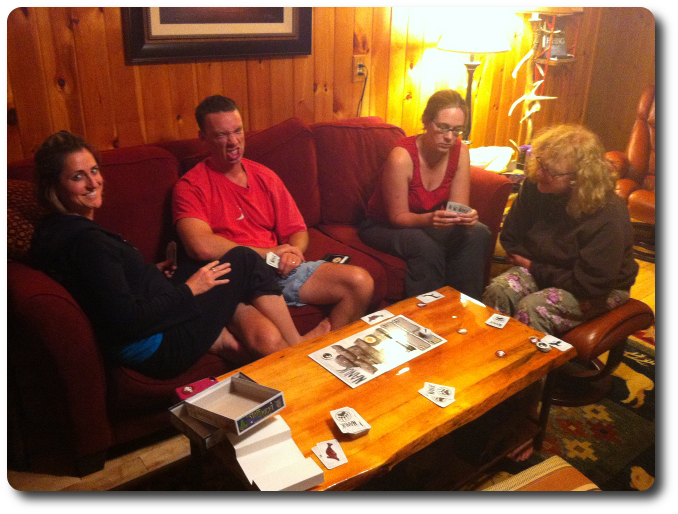
The non-gamers were less than pleased with the game, as the photo clearly shows
Gamer Geeks, this was a game that was built around two main themes: distrust and risk vs. reward. You’ll enjoy the competitiveness of the two sides of doomsayers and hunters, as well as these two main camps constantly shifting throughout the game. Victory is based on properly guessing the outcome of hunts and then thoughtful card collection during rewards to score points. Simply put, there is a good deal to think about in this game to challenge a Gamer Geek and to keep them second guessing themselves throughout. The social aspect of the game, especially when players get to attempt to persuade others to think as they do, is a wonderful opportunity to talk much smack and exercise your right to call out other players to the mat. Every game was a challenge, a heartache, and a wonderfully good time.
Parent Geeks, this game never received enough positive endorsement from your peer group to make us believe it is a good game for you. This game can be seen as a party and family game, but the party and family must be skilled game players, enjoy the challenge of all the guess-work, and put aside any thoughts that they will ever really have any game control. For families with non-gamers or young little geeks, we never observed anything that would suggest it would work well until after many games were played. For the non-gamers, this game confused and befuddled them from start to finish. What we can suggest is playing lots of Liar’s Dice, Werewolf, and Battlestar Galactica. If these games are enjoyed, give Nanuk a try. We think it’ll be much better received and understood.
Child Geeks, your peer group found this game to be terribly confusing and stressful. We do think this is a game you’ll want to play, but we think you should wait until you get older. The game requires the players to be able to read subtle body language of their opponents, understand what is being said and not said during a boast, the need to constantly evaluate and reevaluate the odds of success for the hunt, and to put real thought into card collecting. Nanuk has an interesting mix of social and cognitive skills that are tricky for even adults to master. For now, play other games until you think you are ready.
If you were to put Liar’s Dice, Werewolf, and Battlestar Galactica in a blender, the results would be Nanuk. This game is the perfect mix of risk vs. reward, guess-work, and not trusting a single player you are at the table with. This proved to be a wonderful experience for our Gamer Geeks but for no one else. What I personally loved about the game was the level of thought it took to determine which camp would win during a hunt and the need to collect specific cards to gain points. In essence, this made it a game I had to work with others to succeed, but I was always out for myself from the very start, making it a strange semi-cooperative party game. With this in mind, is it any wonder why some players look at Nanuk and have no idea what the game is about? It’s complex, easy, deep, and shallow at the same time. It is not meant to be taken seriously and yet needs to be played with a serious mind. It’s a hodgepodge of ideas that seemingly contradict each other, but it all works. The result is a game that I love to play and hate to lose.
If you are looking for a party-like game based on cooperative competition, where players must outthink and outwit their own assumptions, with built-in player interaction that sometimes borders on downright passive aggressiveness, then grab your spear and go hunting for Nanuk. This is a game that will be worth your time, energy, and exceedingly high levels of frustration.
This game was given to Father Geek as a review copy. Father Geek was not paid, bribed, wined, dined, or threatened in vain hopes of influencing this review. Such is the statuesque and legendary integrity of Father Geek.



